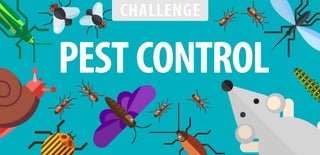Introduction: Sparrow Trap
If you are asking "why trap a poor sparrow?"
Perhaps you do not know that sparrows are "evil cold blooded killers" refer to the link below.
If you have ever tried to attract song birds to your back yard by putting up bird house (bluebirds for example).
You will soon learn that you must manage the sparrows before the bluebirds can occupy the house.
House sparrows will destroy the eggs and/or kill the hatchlings and do basically whatever they can to drive other species away from territory they claim as their own.
Enough of the rant, on with the instructable:
This trap will trap the sparrow in the house as it is tying to stuff it with sticks to make it unusable by competing species (another thing they do) If your are going to use this trap you MUST MONITOR THE HOUSE to make sure you don't trap the species you are trying to attract.
To get the bird out of the house I usually just put a bag over the house and then open the access door.
You can decide what to do with it after you catch it.... mark it... give it a stern talking to.... slap it around a bit.. drive it across the country, mail it to a relative or.....your call.
Step 1: Tools and Supplies
You will need:
Paper template: the size of the frame (non moving part) is about 2 1/2" wide x 3" high.
Some sheet metal: light gauge, this was made with some roof flashing material I had laying around, could probably be aluminum as well. A 6" x 8" sheet should probably be big enough (more if you plan to mess up)
Drill, 1/8" bit (+ smaller bit for pilot holes).
Tin snips.
Spray mount for attaching the template to the sheet metal.
Sheet metal seamer tool: or some wood blocking and and a hammer.
Small chisel or.... something for cutting a tab in the center of piece of sheet metal.
Needle Nose Pliers.
There are of of course likely alternative ways to do all of the steps with different tools.
Step 2: Mount and Cutout
Spray mount the pattern and cut out the shapes with tin snips.
The solid lines are cuts, the dashed lines are folds.
Cut out the shapes, drill pilot holes and then 1/8" holes for the lever arm and the mounting wings.
You can score the dashed lines with a mat knife or some other tool so you can remove the paper prior to bending/folding.
Step 3: Bending Frame
Bend the cutout as shown. Use a hammer and wood blocks or a vice, or pliers or whatever if you don't have the sheet metal seamer tool.
Step 4: Trap Door
This is the moving part of the trap, use the chisel to cut out a notch in the center.
The cuts on the side are what holds the trap door in place before the trap is sprung.
Step 5: Release Lever
This is the lever that springs the door, note the two 90 degree bends at the bottom.
When the sparrow flies in the opening it will land on this piece which will act as a lever that pushes against the trap door piece and release it.
Step 6: Assemble and Adjust
Sorry I forgot two things:
1. you need a rubber band. You could probably use a small spring as well if you find a couple the right size. I just use a rubber band and replace it frequently.
2. you need to cut a couple notches to hold the rubber band at the top (see circled areas)
Assemble the pieces, you will have to bend the tabs on the frame and the lever to get the pins through the holes.
Then you will have to do some fine tuning. It wont all slide together perfectly the first time, folding here, hammering there, straightening etc. until the door moves freely in the frame and the notches in the door catch on the bottom of the frame.
Step 7: Mounting
The trap attaches to a couple of screws set on the inside of the front wall of the bird house.
You of course would remove the trap once you see the appropriate occupants nosing around.
PAINT: THE TRAP SHOULD BE PAINTED TO MATCH THE HOUSE. I did not this step because I did not have any paint and wanted to get this posted before the contest expired.
This was my first instructable. Hope it makes sense.

Participated in the
Pest Control Challenge













